It looks like you're using an Ad Blocker.
Please white-list or disable AboveTopSecret.com in your ad-blocking tool.
Thank you.
Some features of ATS will be disabled while you continue to use an ad-blocker.
37
share:
As everyone really knows it's finding golden treasure that is the most important aspect of archaeology, as after all that is often the medium in which
many cultures represented that which they most valued, accordingly then a consideration here of the Golden treasure of the Sarmatian Dragon Kings.
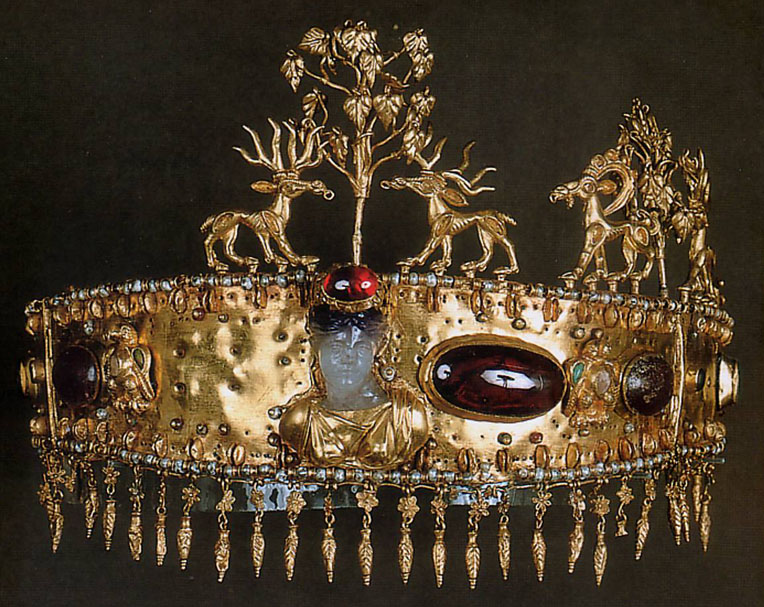
The terms in which i'll be considering it i outlined here, in terms of serpents, roots of the good tree, leading on to what i present in more detail here. In essence this is a cult that developed in the Transtigridian region between Iraq and Iran, Sumer and Elam, some six thousand years ago, and was translated onto the Ukranian steppe through the Iranian connection of the Sarmatians, who were an Aryan people.
They left no written records regarding their religion, the Greeks made a few basic comparisons with some of their own Pantheon, but generally attempts to understand them are muddied and convoluted, hence the need to understand their symbolism.
The most important cultic items are those of the Crowns of the Dragon Kings themselves, as here it is made apparent the connectivity between the Black Underworld, root source, the red terrestrial plane, sacred blood, and the white/translucent stone representing the Celestial Goddess.
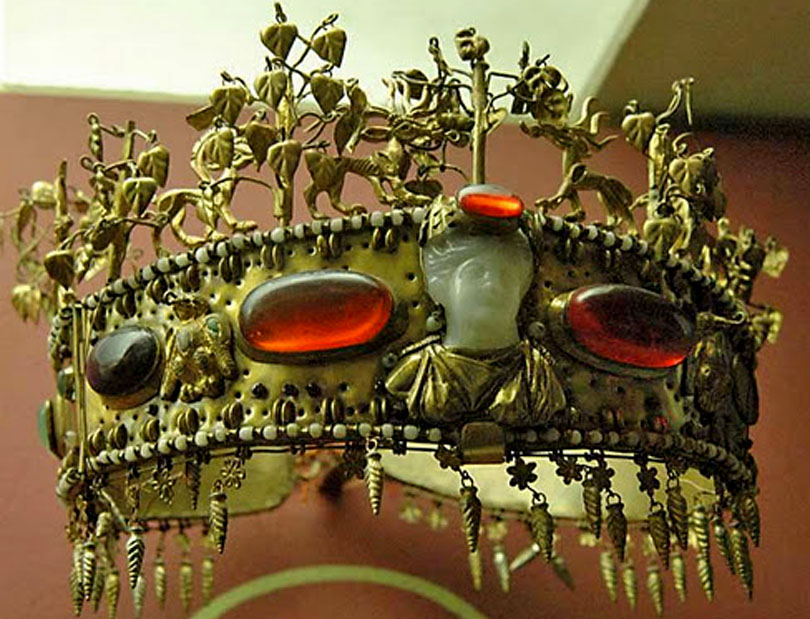
Other elements include the pine cones of the sacred cedar, the symbol of Divine Kingship, the tree that reaches up to the Heavens, the seeds of Dynasties, the split almonds of inner illumination, the deer and mountain goat either side of the trees of life are primarily feminine symbols of the spirit, that moves across the plain and ascends the heights, but also these translate into masculine counterparts, were the masculine goat represents Aphrodite Pandemos, the common love of the people generally accompanied by Eros in representations, these symbols being amongst the earliest and most important of Elam and Sumer.
The birds seen, eagle or hawk, will represent the singular heights attained from the broad base of the root support system.
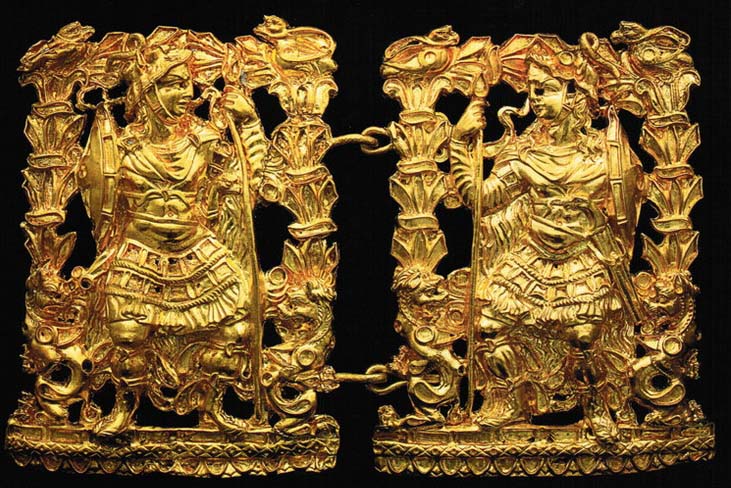
The most important aspect of their religion was parity and balance between the masculine and feminine, as seen above were a male and female warrior are seen either side of a clasp, when closed they are as one, they are each represented by a tree, a dragon at the base and a bird at the top, from excavations male warriors have been discovered wearing this costume which is essentially female, buried with cultic artifacts relating to Aphrodite.
The trees themselves progress upward with numeric symbolism of three, the unification of the three levels of life.
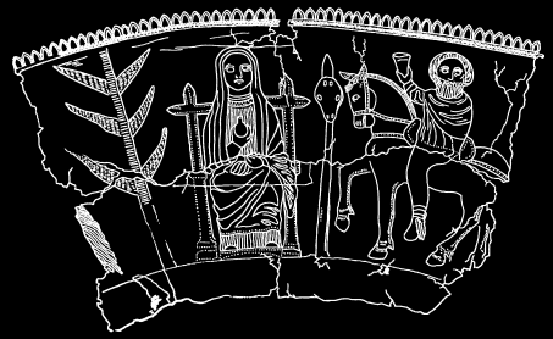
The principle Goddess the Greeks identified, Tabiti, they took as a version of Hestia or Vesta with good reason, in that the Sarmatians also adopted a version of the Iranian fire cult, but rather than the normative Asura progression of Ahura Mazda, Mithra, and Apam Napat, a Trinity with the immortal radiant wisdom as the first principle, the covenant as the second principle, the ecstatic or fire within the waters as the third principle, all bound as one, they appear to have taken Hestia as the first principle, the white Goddess seen upon the crowns, looked to a merging of the masculine and feminine as the second principle, and golden fire of ecstasy as the culmination of this.
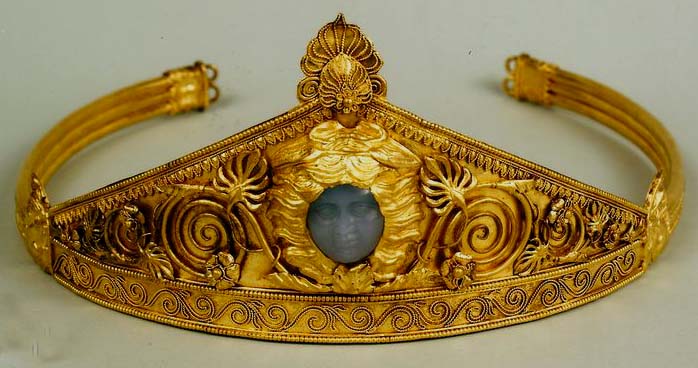
This cult of the pure ever virginal fire of the sacred hearth upon which all else is founded traces back to Sumeria were it is Inanna that creates the tree of her husband Dumuzid drawing on the waters of the Abzu, his role is to love, serve and protect her, to fight as a majestic Dragon if necessary, it is this tradition that is seen to carry on with the Sarmatians, were Hestia reflects the pure Celestial aspect of Inanna, also personified as the Planet Venus.
In Tiara then such as seen above as would be worn by a Dragon Queen, then the sacred fire is seen around the white Goddess, the five petaled flower a motif relating to cycles of Venus, the eight petaled flower related to Celestial rule.
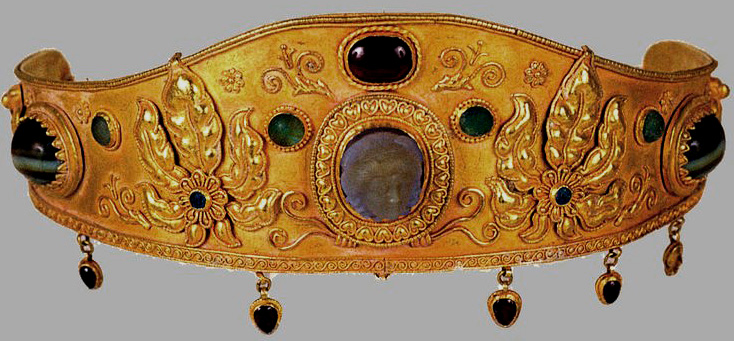
In essence then it was the cult of Inanna and Dumuzid that had found it's way to the Ukranian steppe, one of quite a unique and singular nature, a balance between the Evening star whose nature was that of Aphrodite, Goddess of Love and the Morning star, that established and maintained order on behalf of it, the masculine aspect, but both bound as one.
This parity then reflected in Sarmatian society in terms of equal rights and status for both men and women, were the women could fight as warriors under the Dragon banners.
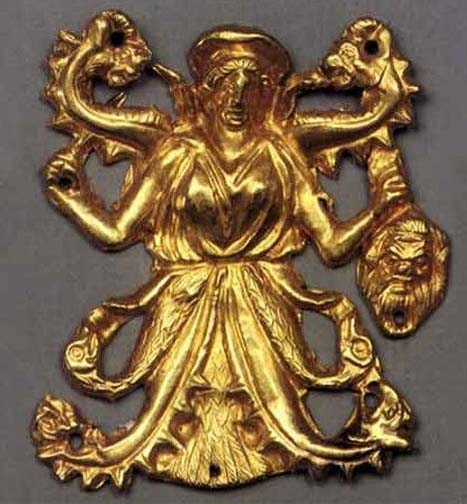
Aspects of these Sarmatian traditions became widespread and highly influential across Europe as they were extensively used as auxilliaries within the Roman army as specialist heavy cavalry, and it is increasingly considered they gave rise to the Chivalric tradition, the Knight serving the pure Lady, their posting and settling as veterans in Britain the most likely source of the Arthurian romances, knights serving under the Dragon banner, the Pen-Draconis.
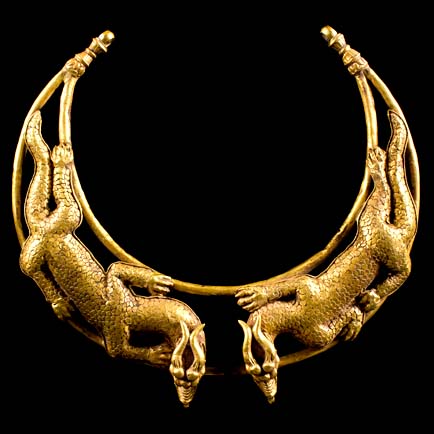
In Hungary The Order of the Dragon was established due to former Sarmatian presence and influence in the region, again based upon the principles of chivalry and the protection of feminine values. It's most notorious member Vlad Dracul was utterly ruthless in punishing any aspect of immoral behavior on the part of women in pursuit of this idealized vision, but the Sarmatians themselves with the cult of Aphrodite Pandemos had maintained all aspects of her cult, not simply the Celestial purity, and were generally seen by the Greeks as a lewd and lustful people, thus later attempts at revivalism were somewhat unbalanced to say the least, similar Sarmatian Orders were established in Poland due to historical connections, among the aristocracy, but again these were elitist.
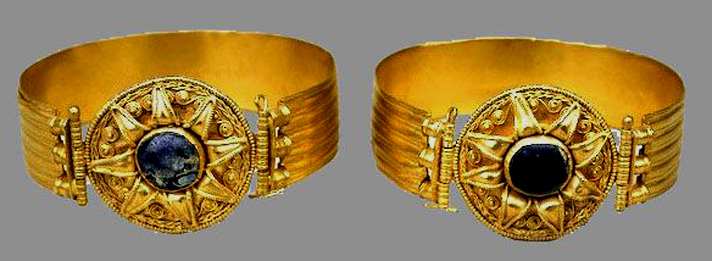
The sacred cauldron or grail of the Sarmatians was held by the white serpent Goddess, only she could invite a suitor to drink from it and share it with her, to drink from the cup of ekstasis, which generally also involved certainty of death shortly after as this was something of a poisoned chalice given the serpent connections in conjunction with a cult of cyclic and seasonal death and regeneration, and thus also drinking from the cup brings immortality, of sorts.
But anyway i hope that gives some insight into these treasures...the Ossetians still perform dance relating to such, as a remnant of the Sarmatian/Scythian peoples close to the heartland.

The terms in which i'll be considering it i outlined here, in terms of serpents, roots of the good tree, leading on to what i present in more detail here. In essence this is a cult that developed in the Transtigridian region between Iraq and Iran, Sumer and Elam, some six thousand years ago, and was translated onto the Ukranian steppe through the Iranian connection of the Sarmatians, who were an Aryan people.
They left no written records regarding their religion, the Greeks made a few basic comparisons with some of their own Pantheon, but generally attempts to understand them are muddied and convoluted, hence the need to understand their symbolism.
The most important cultic items are those of the Crowns of the Dragon Kings themselves, as here it is made apparent the connectivity between the Black Underworld, root source, the red terrestrial plane, sacred blood, and the white/translucent stone representing the Celestial Goddess.

Other elements include the pine cones of the sacred cedar, the symbol of Divine Kingship, the tree that reaches up to the Heavens, the seeds of Dynasties, the split almonds of inner illumination, the deer and mountain goat either side of the trees of life are primarily feminine symbols of the spirit, that moves across the plain and ascends the heights, but also these translate into masculine counterparts, were the masculine goat represents Aphrodite Pandemos, the common love of the people generally accompanied by Eros in representations, these symbols being amongst the earliest and most important of Elam and Sumer.
The birds seen, eagle or hawk, will represent the singular heights attained from the broad base of the root support system.

The most important aspect of their religion was parity and balance between the masculine and feminine, as seen above were a male and female warrior are seen either side of a clasp, when closed they are as one, they are each represented by a tree, a dragon at the base and a bird at the top, from excavations male warriors have been discovered wearing this costume which is essentially female, buried with cultic artifacts relating to Aphrodite.
The trees themselves progress upward with numeric symbolism of three, the unification of the three levels of life.

The principle Goddess the Greeks identified, Tabiti, they took as a version of Hestia or Vesta with good reason, in that the Sarmatians also adopted a version of the Iranian fire cult, but rather than the normative Asura progression of Ahura Mazda, Mithra, and Apam Napat, a Trinity with the immortal radiant wisdom as the first principle, the covenant as the second principle, the ecstatic or fire within the waters as the third principle, all bound as one, they appear to have taken Hestia as the first principle, the white Goddess seen upon the crowns, looked to a merging of the masculine and feminine as the second principle, and golden fire of ecstasy as the culmination of this.

This cult of the pure ever virginal fire of the sacred hearth upon which all else is founded traces back to Sumeria were it is Inanna that creates the tree of her husband Dumuzid drawing on the waters of the Abzu, his role is to love, serve and protect her, to fight as a majestic Dragon if necessary, it is this tradition that is seen to carry on with the Sarmatians, were Hestia reflects the pure Celestial aspect of Inanna, also personified as the Planet Venus.
In Tiara then such as seen above as would be worn by a Dragon Queen, then the sacred fire is seen around the white Goddess, the five petaled flower a motif relating to cycles of Venus, the eight petaled flower related to Celestial rule.

In essence then it was the cult of Inanna and Dumuzid that had found it's way to the Ukranian steppe, one of quite a unique and singular nature, a balance between the Evening star whose nature was that of Aphrodite, Goddess of Love and the Morning star, that established and maintained order on behalf of it, the masculine aspect, but both bound as one.
This parity then reflected in Sarmatian society in terms of equal rights and status for both men and women, were the women could fight as warriors under the Dragon banners.

Aspects of these Sarmatian traditions became widespread and highly influential across Europe as they were extensively used as auxilliaries within the Roman army as specialist heavy cavalry, and it is increasingly considered they gave rise to the Chivalric tradition, the Knight serving the pure Lady, their posting and settling as veterans in Britain the most likely source of the Arthurian romances, knights serving under the Dragon banner, the Pen-Draconis.

In Hungary The Order of the Dragon was established due to former Sarmatian presence and influence in the region, again based upon the principles of chivalry and the protection of feminine values. It's most notorious member Vlad Dracul was utterly ruthless in punishing any aspect of immoral behavior on the part of women in pursuit of this idealized vision, but the Sarmatians themselves with the cult of Aphrodite Pandemos had maintained all aspects of her cult, not simply the Celestial purity, and were generally seen by the Greeks as a lewd and lustful people, thus later attempts at revivalism were somewhat unbalanced to say the least, similar Sarmatian Orders were established in Poland due to historical connections, among the aristocracy, but again these were elitist.

The sacred cauldron or grail of the Sarmatians was held by the white serpent Goddess, only she could invite a suitor to drink from it and share it with her, to drink from the cup of ekstasis, which generally also involved certainty of death shortly after as this was something of a poisoned chalice given the serpent connections in conjunction with a cult of cyclic and seasonal death and regeneration, and thus also drinking from the cup brings immortality, of sorts.
But anyway i hope that gives some insight into these treasures...the Ossetians still perform dance relating to such, as a remnant of the Sarmatian/Scythian peoples close to the heartland.
edit on Kam33171vAmerica/ChicagoThursday1331 by Kantzveldt because: (no reason given)
reply to post by Kantzveldt
I have nothing cool to say to this...
Just - Thanks!
Outstanding piece.
Oh Yeah - - Any idea 'where' their idea/s and visualization of "dragons" derived from?
I have nothing cool to say to this...
Just - Thanks!
Outstanding piece.
Oh Yeah - - Any idea 'where' their idea/s and visualization of "dragons" derived from?
reply to post by WanDash
Sure, the sign for tree roots was crossed serpents in Sumeria, a force of nature as water that travels through the roots and up through the tree itself finally taking to the air, and taking upon itself the aspect of fiery gold, in the sense of the leafs as scales, i outlined this here, even the Chinese probably mass reproduced Dragons that were introduced from the Eurasian steppe.
Sure, the sign for tree roots was crossed serpents in Sumeria, a force of nature as water that travels through the roots and up through the tree itself finally taking to the air, and taking upon itself the aspect of fiery gold, in the sense of the leafs as scales, i outlined this here, even the Chinese probably mass reproduced Dragons that were introduced from the Eurasian steppe.
I've been looking for my golden dragon necklace for a long loooong time. amazingly beautiful.
If I had one wish granted it would be a time machine. I would go back every 100 years for one day for an entire year and find the perfect 1 second still photo. I would return after that year with 365 photos spanning a time period of 36,500 years and create a "Life of Humanity" photo video.
One can dream.
Edit to add: If anyone out there is successful with the development of a time machine, please consider taking sir dodo with you. Thanks in advance.
If I had one wish granted it would be a time machine. I would go back every 100 years for one day for an entire year and find the perfect 1 second still photo. I would return after that year with 365 photos spanning a time period of 36,500 years and create a "Life of Humanity" photo video.
One can dream.
Edit to add: If anyone out there is successful with the development of a time machine, please consider taking sir dodo with you. Thanks in advance.
edit on 13-3-2014 by Rosinitiate because: (no reason given)
reply to post by Kantzveldt
That's a nice track, I liked the breakdown and build. Makes me miss the old days of dropping vinyl at the clubs and although I played all genres of techno, i primarily focused on funky Florida break beats.
That's a nice track, I liked the breakdown and build. Makes me miss the old days of dropping vinyl at the clubs and although I played all genres of techno, i primarily focused on funky Florida break beats.
Pan always depicted as half-man half-goat and was a bit of trickster, but non-the-less a deity
of lust and desire. The half & half nature demonstrated the animalistic nature of man, hence the bottom half where the naughty bits are was the
bestial goat.
Demos is the body of people, so the cult of worship of Venus/Aphrodite.
However this is not just the worship of the goddess of Love, the higher ideals of the mind and soul. It was more defined by combining it with the lower basic instincts of lust and desire by being Pandemos...The dual natures of Human sexuality, both the sensual and hardcore!
Eros also held the surname title of Pandemos along with Aphrodite...of course this all leads up to the cult of spring and fertility does it not?
But fine let the pandemonium begin...
Spring has arrived early here, a time for lovers and it's as if the season mocks my sadness
Demos is the body of people, so the cult of worship of Venus/Aphrodite.
However this is not just the worship of the goddess of Love, the higher ideals of the mind and soul. It was more defined by combining it with the lower basic instincts of lust and desire by being Pandemos...The dual natures of Human sexuality, both the sensual and hardcore!
Eros also held the surname title of Pandemos along with Aphrodite...of course this all leads up to the cult of spring and fertility does it not?
But fine let the pandemonium begin...
Spring has arrived early here, a time for lovers and it's as if the season mocks my sadness
reply to post by abeverage
I think too much paranoia there, Aphrodite Pandemos was simply how aspects of a mystery cult of love permeated into the lives of the common people and nature, Heavenly Aphrodite Urania being somewhat more difficult to get a fix on, but still the highest ideal, and inside every little Pandemos one could be found, you don't need to be going off on a grail quest....
I think too much paranoia there, Aphrodite Pandemos was simply how aspects of a mystery cult of love permeated into the lives of the common people and nature, Heavenly Aphrodite Urania being somewhat more difficult to get a fix on, but still the highest ideal, and inside every little Pandemos one could be found, you don't need to be going off on a grail quest....
reply to post by Kantzveldt
I will need to read more....but it appears that their "religion" is the same as all others. But maybe more close to the source?
What you are describing, and what I am seeing, is an outward expression of The Mysteries.
This is fascinating beyond explanation. Thank you for sharing.
I will need to read more....but it appears that their "religion" is the same as all others. But maybe more close to the source?
What you are describing, and what I am seeing, is an outward expression of The Mysteries.
This is fascinating beyond explanation. Thank you for sharing.
reply to post by Kantzveldt
The fascinating ossetian dancing is very similar to that practiced by the Mari El who worship in tree groves. On the basis of pagan tree worship often connected with fertility i would hazard a crazy guess that the top picture would nowadays be known as a May Queen crown and the jewels remind me of amber/pine resin and perhaps honey made by bees attacted to the trees. Thanks for the interesting post
The fascinating ossetian dancing is very similar to that practiced by the Mari El who worship in tree groves. On the basis of pagan tree worship often connected with fertility i would hazard a crazy guess that the top picture would nowadays be known as a May Queen crown and the jewels remind me of amber/pine resin and perhaps honey made by bees attacted to the trees. Thanks for the interesting post
reply to post by bigfatfurrytexan
The Iranian factor is what connects it to earliest known source, but that began 4,000 years previous to the Sarmatians in the border regions of Southern Iraq and Western Iran, so quite a remarkable translation to Ukrania and a fairly non-literate society hence the importance of the symbolic representations.
Even the cults of Inanna and Dumuzid were in serious decline at that period in their former heartland, and the later adaptations, so i can only surmise that a group of die-hards had maintained and re-established the beliefs and practises of former times, grafting those onto a different people, perhaps also involving the continuity of a bloodline.
reply to post by spannera
It is fascinating, the upper body so upright and motionless as the trunk of a tree, the feet doing all the work, and the twelve wise virgins gliding along seemingly in a ghost like manner, makes sense in the context of the beliefs i outlined.
The Iranian factor is what connects it to earliest known source, but that began 4,000 years previous to the Sarmatians in the border regions of Southern Iraq and Western Iran, so quite a remarkable translation to Ukrania and a fairly non-literate society hence the importance of the symbolic representations.
Even the cults of Inanna and Dumuzid were in serious decline at that period in their former heartland, and the later adaptations, so i can only surmise that a group of die-hards had maintained and re-established the beliefs and practises of former times, grafting those onto a different people, perhaps also involving the continuity of a bloodline.
reply to post by spannera
It is fascinating, the upper body so upright and motionless as the trunk of a tree, the feet doing all the work, and the twelve wise virgins gliding along seemingly in a ghost like manner, makes sense in the context of the beliefs i outlined.
edit on Kpm33171vAmerica/ChicagoThursday1331 by
Kantzveldt because: (no reason given)
Kantzveldt
...It is fascinating, the upper body so upright and motionless as the trunk of a tree, the feet doing all the work, and the twelve wise virgins gliding along seemingly in a ghost like manner, makes sense in the context of the beliefs i outlined.
Sorry to interlope, here, but - your description of this 'dance' reminds me of a 'dance' I studied (in books) years ago...
It was/is the Fandango. It was supposed to have derived in the Great Pyrenees in the south of France & northern Spain.
It's roots were purported to have derived from the same 'dance' that developed into belly-dancing...but that predated the same, and may have been derived from an even earlier 'dance'.
The point to this is - There is a particular dance that comes out of the Fandango, called the Fandanguillo.
This dance is performed by a single female, whose upper body remains 'virtually' rigid through most of the dance - but, she is, in fact, exerting more energy than perhaps any other dance requires, as - she is in a virtual tremble, through much (if not all) of the performance.
I have read that this may be the most difficult dance in the world.
I have searched the Internet since first being introduced to...the Internet...for ANY video of a performance of this dance, and have yet to find one (all I have found are the guitar pieces that are purported to accompany).
Realize this is a long shot - but, are you familiar with this...and thus - is it possibly related to the dance you described, above?
Thanks Much.
reply to post by WanDash
Yes i can see similarities in the way that it is performed as a group, probably introduced by the Arabs, who possibly took the dance from Iran?
Yes i can see similarities in the way that it is performed as a group, probably introduced by the Arabs, who possibly took the dance from Iran?
reply to post by Kantzveldt
Thank you.
It has been more than 20 years since I studied/researched this dance...and that research was done in a number of metropolitan libraries - and, now - multiple notions and takes on the subject can be found with the click of a mouse.
That research was transferred to very old floppy disks - and then, a flood ruined them.
I do recall that the dance was generally performed at or around or next to a fire (could be a candle in 'proper' settings).
Appreciate your reply!
Thank you.
It has been more than 20 years since I studied/researched this dance...and that research was done in a number of metropolitan libraries - and, now - multiple notions and takes on the subject can be found with the click of a mouse.
That research was transferred to very old floppy disks - and then, a flood ruined them.
I do recall that the dance was generally performed at or around or next to a fire (could be a candle in 'proper' settings).
Appreciate your reply!
Nice pics, but the artifacts aren't as old as implied, nor were the Sarmatians.
The artifacts date to about the 1st Century AD.
Sarmatians first arose sometime around the 7th Century BC, not 6,000 years ago - as stated in the O.P..
Harte
The artifacts date to about the 1st Century AD.
Sarmatians first arose sometime around the 7th Century BC, not 6,000 years ago - as stated in the O.P..
Harte
reply to post by Harte
No i never implied these artifacts were 6,000 years old or were Sumerian or Elamite, as i've previously stated here Sarmatian and 1st century AD, what i was saying is that the motifs and cultic tradition behind them date back to that region and period, perhaps i should have provided more examples in order to better explain.
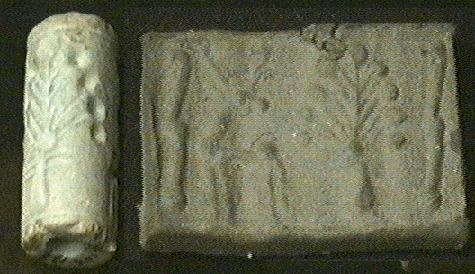

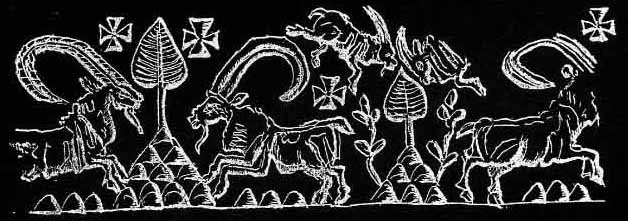
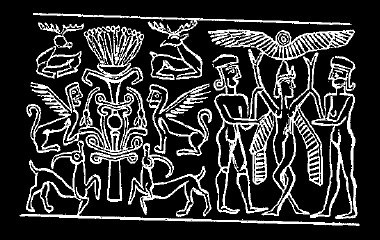
No i never implied these artifacts were 6,000 years old or were Sumerian or Elamite, as i've previously stated here Sarmatian and 1st century AD, what i was saying is that the motifs and cultic tradition behind them date back to that region and period, perhaps i should have provided more examples in order to better explain.




Kantzveldt
reply to post by Harte
No i never implied these artifacts were 6,000 years old or were Sumerian or Elamite, as i've previously stated here Sarmatian and 1st century AD, what i was saying is that the motifs and cultic tradition behind them date back to that region and period, perhaps i should have provided more examples in order to better explain.
Here's where I misunderstood:
The terms in which i'll be considering it i outlined here, in terms of serpents, roots of the good tree, leading on to what i present in more detail here. In essence this is a cult that developed in the Transtigridian region between Iraq and Iran, Sumer and Elam, some six thousand years ago, and was translated onto the Ukranian steppe through the Iranian connection of the Sarmatians, who were an Aryan people.
I see now what you meant.
Sorry.
Harte
WanDash
reply to post by Kantzveldt
I have nothing cool to say to this...
Just - Thanks!
Outstanding piece.
Oh Yeah - - Any idea 'where' their idea/s and visualization of "dragons" derived from?
Agreed. Very cool indeed.
new topics
-
Joe Rogan conspiracy (maybe)
ATS Skunk Works: 2 hours ago -
Results of the use of the Oreshnik missile system in Dnepropetrovsk
World War Three: 5 hours ago -
Nigel Farage now the Most Favoured UK Politician
Regional Politics: 6 hours ago
top topics
-
Little Johnny and Larry should team up
General Chit Chat: 12 hours ago, 10 flags -
Results of the use of the Oreshnik missile system in Dnepropetrovsk
World War Three: 5 hours ago, 10 flags -
Nigel Farage now the Most Favoured UK Politician
Regional Politics: 6 hours ago, 3 flags -
Will Us use alien technology to fight in ww3?
World War Three: 13 hours ago, 2 flags -
Joe Rogan conspiracy (maybe)
ATS Skunk Works: 2 hours ago, 2 flags
active topics
-
Results of the use of the Oreshnik missile system in Dnepropetrovsk
World War Three • 128 • : WeMustCare -
President-Elect DONALD TRUMP's 2nd-Term Administration Takes Shape.
Political Ideology • 240 • : WeMustCare -
Nigel Farage now the Most Favoured UK Politician
Regional Politics • 6 • : angelchemuel -
President-Elect TRUMP Picks Former Florida A.G. PAM BONDI to be U.S. Attorney General.
2024 Elections • 56 • : VariedcodeSole -
Well we know Putins ICBMs won't fail in their silos
World War Three • 209 • : Xtrozero -
Jaguar Rebrand Video Causes "WTF?" Moment - Seriously Weird
Automotive Discussion • 26 • : angelchemuel -
Post A Funny (T&C Friendly) Pic Part IV: The LOL awakens!
General Chit Chat • 7815 • : baddmove -
Joe Rogan conspiracy (maybe)
ATS Skunk Works • 2 • : watchitburn -
Little Johnny and Larry should team up
General Chit Chat • 3 • : bluesman023 -
Will Us use alien technology to fight in ww3?
World War Three • 11 • : BeyondKnowledge3
37
